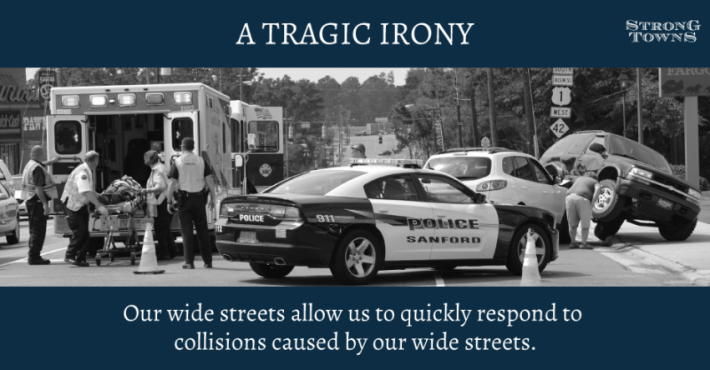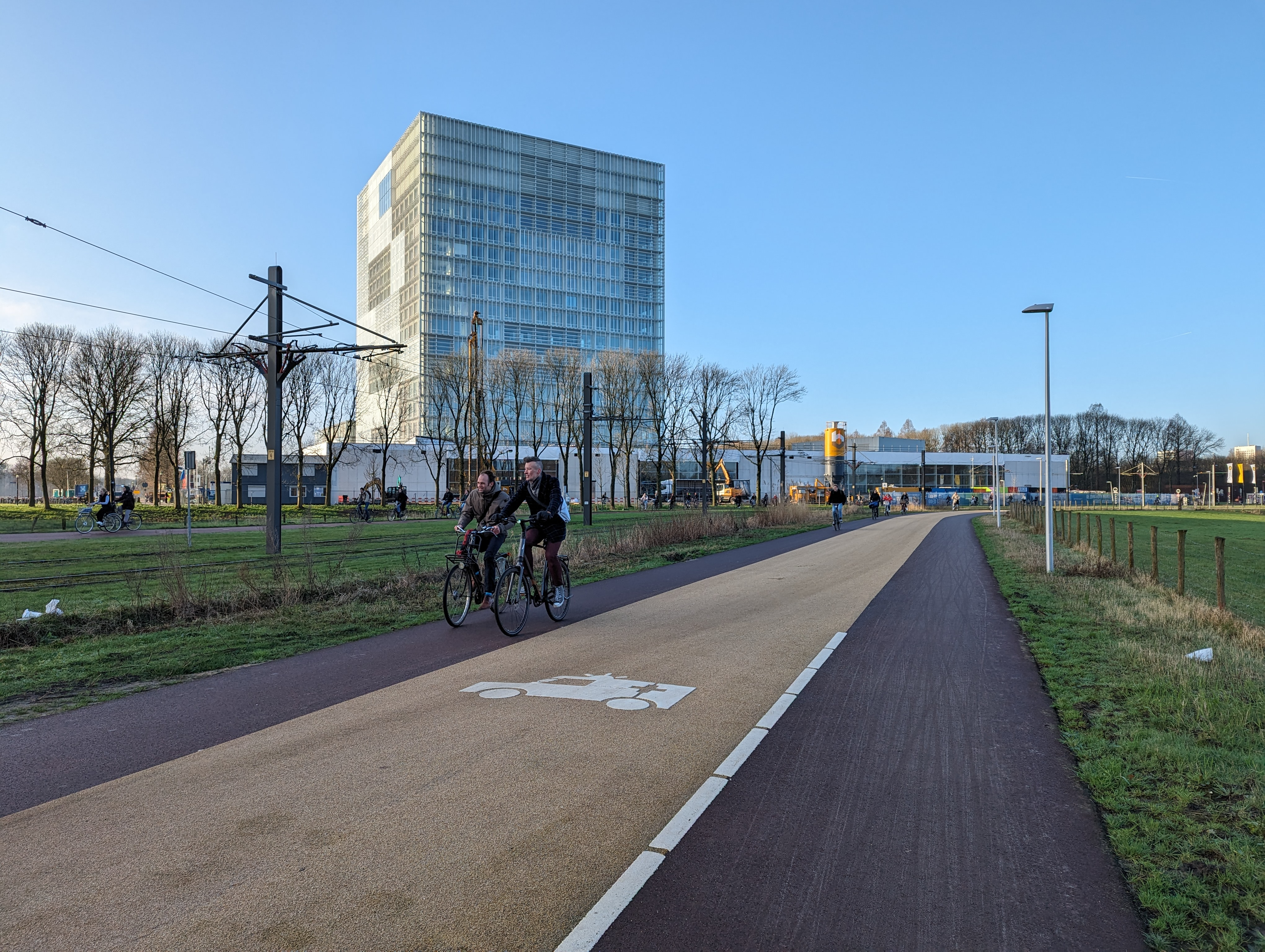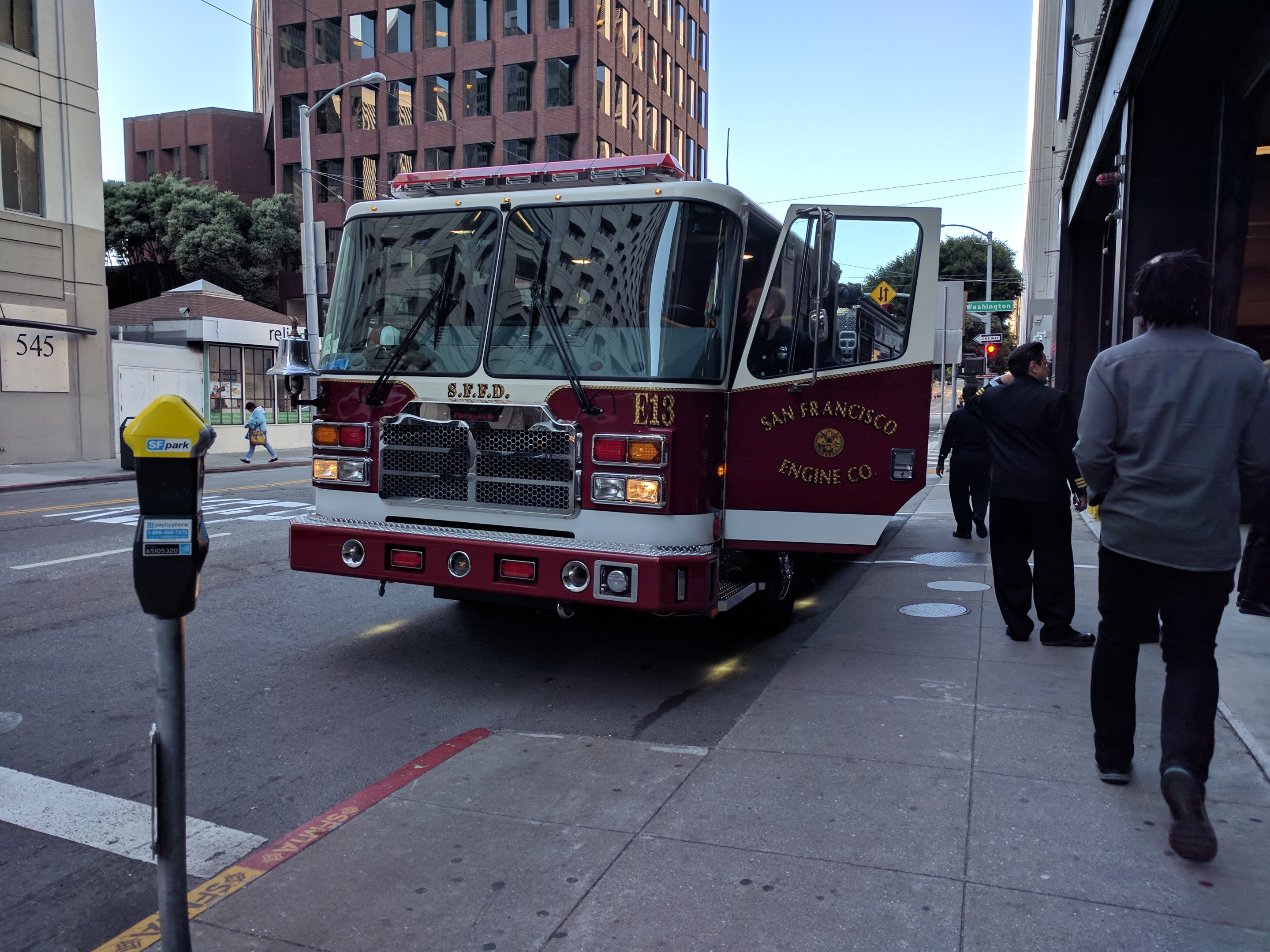Editor Note: As Streetsblog readers are no doubt aware, city fire departments have sometimes been an impediment to the installation of protected bike lanes. They claim that reducing the width of the street slows response times and can cause issues for ladder trucks. While most of this has been debunked, the push back continues, most recently in Los Angeles where the firefighters union there actively campaigned against a safe-streets ballot measure (which passed handily). The Dutch Cycling Embassy asked Streetsblog to run a recent post of theirs about how bike lanes and fire trucks can co-exist to the advantage of everyone. The following lays out an advocacy strategy.
***
Bicycle promotion initiatives on a global scale often encounter resistance, particularly concerning their supposed negative impact on emergency response services. As a result, conflicts have emerged as fire departments oppose the construction of bicycle paths. They fear that these paths may narrow road lanes, potentially violating fire code specifications. This sentiment that cycle lanes hinder emergency services is frequently echoed by anti-cycling advocates. However, examples both within and outside the Netherlands challenge this notion, demonstrating that the development of bicycle infrastructure can coexist with the swift passage of emergency vehicles and, in some cases, even enhance emergency response times. A recent study conducted in Paris, for instance, revealed that the introduction of bicycle lanes led to expedited response times for firefighters in the city.
Impelled to gain a deeper understanding of this subject, the Dutch Cycling Embassy conducted an exploratory research to understand how and why a coexistence between swift emergency response and a thriving bicycle culture is achievable. Through the examination of best practices and conversations with relevant stakeholders, several key insights have emerged that are presented in this blogpost. While this blog is not intended as a design guide, its aim is to inspire and encourage more constructive and collaborative approaches to integrating bicycle-promotion efforts with emergency response requirements.
Be tactical about implementing traffic calming measures.
Traffic calming measures are popular and effective measures to create a bicycle-friendly environment. A few of the most implemented traffic calming measures include speed humps, roundabouts, traffic circles, and chicanes. The main goal of these traffic calming measures is to reduce vehicular speeds and hereby create environments that are safer and more conducive for walking and cycling. Studies have consistently shown that reducing automotive speeds to 30 km/h can dramatically decrease cyclist and pedestrian fatalities. These measures thus help to achieve Vision Zero, “a strategy to eliminate all traffic fatalities and severe injuries, while increasing safe, healthy, equitable mobility for all.”

However, concerns have arisen among emergency responders, particularly within the fire brigade and ambulance services, regarding the potential negative impact of such measures on emergency response times. For instance, speed humps can lead to a delay of up to 9.4 seconds per speed hump, depending on their respective size and that of the emergency vehicle. Despite this, Dan Burden, author of the manual “Emergency Response: Traffic Calming and Traditional Neighborhood Streets,” contends that well-designed traffic calming initiatives need not impede emergency response times; in fact, they may even improve them.
Hence, it is important to be tactical about implementing traffic calming. For one, the (excessive) use of speed humps or other types of vertical traffic calming measures on main emergency response routes is discouraged. Aside from causing delays, these measures can pose risks of damage to larger emergency vehicles and discomfort to patients in ambulances. Instead of implementing speed humps, speed cushions could serve as a suitable alternative, as they have very minimal to no impact on emergency response times. Their smaller size allows larger emergency vehicles to drive over them without significantly reducing speed, while they still effectively slow down regular private vehicles.
Another widely adopted traffic calming measure is the construction of roundabouts at intersections. While roundabouts aim to improve traffic flow and reduce accidents, opinions on their impact on emergency response times vary among stakeholders. Michael Unterhalt, a safety advisor and former firefighter from Germany, advocates for roundabouts over traffic light-controlled intersections. He argues that roundabouts generally allow traffic to keep moving, unlike intersections where traffic periodically comes to a standstill. Dan Burden echoes this argument, stating that most roundabouts “tend to speed up rather than delay emergency responders.” Yet, to be effectively used by emergency vehicles, the roundabout’s design should accommodate the considerable size of most emergency vehicles. This involves creating wide entry lanes, incorporating mountable curbs, and ensuring sufficiently large radii to facilitate smooth passage for these vehicles.
However, conversations with the Utrecht Safety Region have highlighted potential drawbacks of implementing roundabouts. They point out that blind spots around roundabouts may hinder the visibility of approaching emergency vehicles. As a result, drivers of private vehicles may not always clear the road in time. With traffic light-controlled intersections this problem can be undermined by remotely activating the green lights for approaching emergency vehicles.
Thus, while implementing traffic calming measures are crucial for creating safer environments for (active) mobility, their impact on emergency response times can vary. To ensure that that traffic calming efforts meet the requirements for swift emergency response necessitates effective collaboration among stakeholders. This underscores the importance of our next point of attention!
Facilitate effective collaboration among relevant stakeholders.
To ensure that cycling infrastructure meets the safety standards required by emergency responders, fostering effective collaboration among relevant stakeholders is paramount. One effective strategy to facilitate this collaboration could involve the formation of a dedicated committee, comprising representatives from diverse municipal departments. Utrecht’s model serves as an example, where a committee oversees the comprehensive aspects of public space management, design, and utilization. Colleagues from different municipal departments are included in this committee, such as the Green, Road Management, and Urban Planning departments. Importantly, it also incorporates representatives from essential emergency services like the fire brigade and the police. Their presence guarantees that proposed redevelopment plans align with safety requirements and emergency response protocols. By convening bi-weekly, the committee ensures that emerging issues can be discusses in a timely manner and alternative designs can be explored collaboratively.
It is worth considering involving emergency responder personnel at an even earlier stage in the process. By integrating their expertise into the development of infrastructure design guides, safety requirements can be seamlessly incorporated into the design process, minimizing challenges that may arise during redevelopment initiatives.
Carefully consider integrating bicycle lanes into the emergency response routes.
Another notable discussion revolves around the potential utilization of bicycle lanes by emergency vehicles. The study conducted in Paris, for example, partly attributed the shortened emergency response times for firefighters to their ability to use bicycle paths to bypass any build-ups of cars.
Nevertheless, not all are in favor of using bicycle paths as emergency lanes, as the road actors that typically make use of bicycle lanes are inherently more vulnerable than emergency vehicles. In the Netherlands, emergency responders are allowed to use bicycle lanes in priority 1 and priority 2 cases, the categories with the highest urgency. Still, they are cautious about using them, and only do so when deemed absolutely necessary and safe. For instance, if children are cycling on the path, emergency responders may choose alternative routes, even if other entry points are obstructed by vehicular traffic or roadblocks.
Yet, there are also examples where bicycle lanes are integrated into emergency response routes. One example where a bicycle lane was constructed with emergency responders in mind is a newly constructed path at the Utrecht Science Park. Even though this is not a conventional solution, the design was approved by emergency responders and shows how bicycle and emergency response do not inherently have to exclude each other. The path is made wide enough so that cyclists can easily move to the sides, leaving enough space for the emergency vehicle to pass. Notably, this path is not part of the main emergency route towards the hospital but may serve as an alternative route in case the main route is obstructed.

This ultimately shows that while cyclists and emergency responders have different characteristics and needs, bicycle infrastructure and swift emergency response times do not need to exclude each other. Through constructive collaboration solutions can be found to cater to the needs of both.
Reduce congested streets through bicycle-promotion efforts.
Bicycle-promotion initiatives offer more than just advantages for cyclists; they also present opportunities to improve conditions for emergency responders. A key advantage lies in the lower spatial footprint of bicycles compared to cars. By discouraging car use and actively promoting cycling, these initiatives contribute to freeing up more space on the roads. Studies have shown that shifting car trips to cycle trips reduce congestion in the city, which may prove beneficial for emergency response times. Moreover, reduced reliance on cars can translate into fewer parked cars lining the streets, further optimizing passage for emergency responders.
Consider using smaller fire trucks.
A final consideration to be made is the use of smaller fire trucks among the fire brigades. Smaller fire trucks have lower spatial requirements, allowing for smaller streets for vehicular traffic. Consequently, the space that is freed up can be reallocated to the construction of bicycle paths.
Michael Unterhalt advocates for the deployment of such smaller firetrucks, arguing that quite often, smaller emergency vehicles are a lot cheaper and more efficient. A report from the U.S. Department of Transportation’s Volpe National Transportation Systems Center concluded the same. One of the key findings mentioned in their report states that:
“Smaller, more maneuverable emergency response trucks often have similar, or better, capabilities than the most common trucks on the streets in U.S. cities today. Aerial ladder fire trucks used in major European and Asian cities can reach just as high, despite being only two-thirds as long and having only half of the turn radius as common American models. Some models of pumper fire trucks are up to 30% smaller, and have a turn radius up to 50% less than more typically procured models.”
Some cities are already experimenting with the use of smaller fire trucks. The San Francisco Fire Department, for example, introduced the ‘Vision Zero Truck’. This new fire engine is designed to navigate people-friendly streets while addressing concerns of quick emergency response. The Vision Zero truck is “ten inches shorter and two inches narrower than the department’s older trucks, and the turning radius has been knocked down to 25 feet from 33,” allowing firefighters to maneuver through bike lanes and crowded roads. This innovation signifies a compromise between safe street advocates and the fire department, recognizing that in the end they share the same goal: improving safety.







